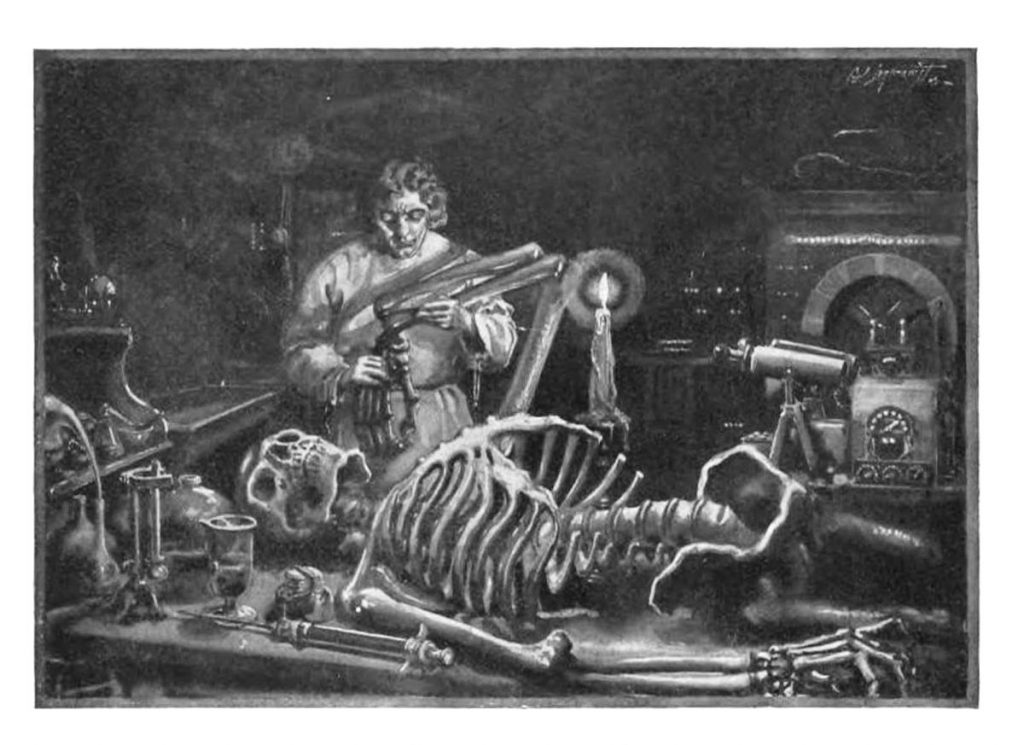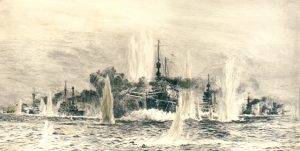Two hundred years after Frankenstein’s release, scholars and casual readers alike continue to study Mary Shelley’s most prominent work. On the surface, Frankenstein is simple horror: a gruesome monster turns against the scientist who created him and attacks his creator’s loved ones. One could argue that Shelley intended to warn readers against hubris, and that pushing outside the natural boundaries of science has consequences. However, a closer examination of the text reveals a social commentary in addition to the scientific one. Rather than begin Victor Frankenstein’s tale with his creation of the Monster, Shelley introduces the scientist as a dying man.1 The ailing scientist first reflects back on the events of his early years: his mother’s death and time spent with Elizabeth, a childhood companion who Victor later marries. As the story progresses, Shelley depicts not just the aftermath of the Monster’s attacks, but his interactions with Victor that precede the violence. When taken together, these moments weave a cautionary tale deeper than the apparent scientific warnings. In Victor’s treatment of the Monster, as well as the text’s depiction of women, Shelley paints a world in which the privileged class handles the outsider with disdain, and, in doing so, faces dire consequences.
To fully grasp Shelley’s intent in Victor’s treatment of the Monster, the reader must first consider who Victor is before he brings the Monster to life. In the first seconds of his tale, Victor states that his “family is one of the most distinguished” in Geneva.2 Even when he moves away to school, the young man has a “servant” available to wait on him.3 Furthermore, by pursuing education, Victor seeks “to join the new class of learned men” who “replaced the landed gentry as the upper society in Europe.”4 Through both heredity and action, Victor manifests the privileged class. Of course, the Monster does commit atrocities throughout Frankenstein, but not in his first living moments; if the Monster were inherently evil, he would have killed Victor when he was first brought to life. Therefore, any interaction between the two should not be viewed as man versus creature, but rather as a privileged being versus an outsider.With this context in mind, Victor’s treatment of his creation is clearly problematic. In perhaps the text’s most gripping moment, Victor marvels at the Monster as “the shriveled complexion and straight black lips” come alive. “Beautiful!” Victor exclaims.5 He dwells on every aspect of the Monster’s appearance, amazed at his own handiwork until he sours at the “horrid contrast” between the Monster’s “teeth” and “watery eyes.”6 In this scene, Victor never considers that he has somehow usurped the natural order or even that the Monster might turn out to be evil. He simply dotes on the physical appearance of his creation. So, when Victor “rushe[s] out of the room,” it is because he is disgusted by the pure physicality of the Monster, and not because of some terrifying moral epiphany.7

Aside from Victor’s initial fright—which would be understandable were he not the Monster’s creator—his aversion to his own creation never improves. Following the murder of Victor’s younger brother, William, Victor returns home to Geneva and eventually travels to Mont Blanc. As Victor navigates “the field of ice” at the mountain’s base, the monster appears, confronts Victor, and convinces his creator to follow him into a hut.8 Here, Victor asserts that he now understands “the duties of a creator towards his creation,” and this statement might seem true, considering Victor finally speaks with and listens to the creature.9 However, one must also consider that the Monster is both physically more powerful than Victor and Victor believes the Monster has murdered young William, suggesting that Victor never really has a choice in accompanying his creation. Once inside the hut, the Monster details his failed encounters with humans since he last saw his maker, and finally begs Victor to create a second life so that he may have a companion. Victor initially complies, believing that with a mate, the two creatures may find solace together away from Europe.10 While conflicted about bringing a second life into the world, Victor only rips apart the lifeless body of this creation when he sees his first creature staring in through the laboratory window.11 In this series of interactions between the young scientist and his creation, Victor is always motivated by the Monster’s appearance rather than by his actions.
In addition to the major plot events involving Victor, Shelley uses two subtle moments to comment on the Monster’s place in society. Scholar Anne Mellor explains, “only two characters…do not immediately interpret the creature as evil.”12 The blind Father De Lacey, who the monster tells Victor he encountered during his travels, cannot evaluate the Monster’s appearance. And the ship captain, Walton, who finds the dying Victor at the story’s very beginning, hears Victor’s description of the Monster before meeting him. Both men treat the creature with kindness.13 While neither of these characters advances the main narrative forward in the manner Victor does, they both depict a humane response to the creature, and, in doing so, highlight Victor’s cruelty towards his own creation. Unlike Father De Lacey and Walton who come away from their encounters with the Monster unscathed, Victor faces extreme consequences for abusing his creation. Indeed, Victor’s family is both literally and figuratively torn apart by the Monster. And, upon finally deciding to rid the world of his creation, Victor chases the Monster into the Arctic, where he is consumed by the hostile elements and eventually “sinks…into apparent lifelessness.”14 In essence, Victor manifests privilege; he is born into an influential household and receives opportunities others cannot. Contrarily, Victor’s creation is jerked into a hostile world where he is judged entirely by his appearance. Victor’s treatment of his creation—the outsider—is motivated entirely by the superficial trappings of physical appearance, a trap that ends in disaster for Victor and thereby the upper class he represents.

Underneath the plot’s surface lies a less obvious but equally important commentary on how humans treat one another. “Frankenstein,” authors Dorothy and Thomas Hoobler assert, “is a novel of male voices.”15 Indeed, this novel relies on three different narrators—all of whom are male—and focuses almost entirely on male characters. As “many Gothic novels…written by women” feature a “heroine rather than a hero,” the reader must examine why Mary Shelley would relegate women in Frankenstein to the background.16 Two sections in this novel should be of particular interest to the reader. First, as a child, Victor does express interest in science, but he does not progress from reading to experimentation until later; immediately after his mother dies, he departs for the “all-male world of the university.”17 Once at Ingolstadt, isolated “from the feminine” influence that defined his childhood, Victor falls into the dark world of pushing outside science’s moral boundaries.18 Secondly, while Victor loves Elizabeth enough to marry her, she remains absent for most of the text, providing almost no value to the narrative until the end. Once the Monster kills Elizabeth, Victor finally resolves to destroy his creation. Therefore, Elizabeth’s only significant contribution to the text is as a passive recipient of another character’s action.

While one could argue that the lack of female representation in Frankenstein constitutes nothing more than Shelley’s desire to highlight the struggle between Victor and his creation, this argument fails to examine Shelley’s other options as an author as well as the context in which the book was written. Were Shelley only concerned with the scientific aspects of Frankenstein, she would have begun Victor’s narrative in a far more interesting place than his childhood, perhaps in the morgue searching for limbs to fuse together. Furthermore, the Monster’s first murder could have just as easily provoked Victor to action. These alternatives delineate that Shelley’s choice to include Victor’s mother and Elizabeth’s murder in the narrative was a deliberate one. Furthermore, it was “a common convention for women writers” in the early nineteenth century to publish their work anonymously as Mary Shelley did with her 1818 version of Frankenstein.19 This unfortunate reality of the time means Shelley would have been aware that female involvement in a work—as an author or as characters—could diminish the book’s reception, thereby reducing her opportunity to make a point about the treatment of women in society. Her later work, published after Shelley achieved financial independence from her husband, was “highly political.”20 Considering this context, it appears Shelley wanted to make a statement with her female characters but knew doing so would damage the book’s credibility, so she chose instead to make a statement with their absence.
In short, while Frankenstein does, of course, show scientific experimentation devolved into calamity, the cautionary aspect of this tale lies in the human interactions. As both a member of an elite family and an educated scientist, Victor manifest the privileged class who make decisions regarding the lives of others. Responsible for the creation of the outsider, Victor then treats that outsider with disdain, a choice which eventually leads to Victor’s downfall. Hidden inside this narrative is a commentary on a specific class of outsider: women. If Victor portrays the privileged class in society, then his mother is the feminine influence that goes unheard. Shelley’s warning here is significant: viewing the outsider as a monster and ignoring the voices of society’s unseen members can prove disastrous.
- Mary Shelley, Frankenstein (New York: Barnes & Noble Books, 2003), 21. ↵
- Mary Shelley, Frankenstein (New York: Barnes & Noble Books, 2003), 27. ↵
- Mary Shelley, Frankenstein (New York: Barnes & Noble Books, 2003), 54. ↵
- Lars Lunsford, “The Devaluing of Life in Shelley’s FRANKENSTEIN,” Explicator 68, no. 3 (2010): 174. ↵
- Mary Shelley, Frankenstein (New York: Barnes & Noble Books, 2003), 51. ↵
- Mary Shelley, Frankenstein (New York: Barnes & Noble Books, 2003), 51. ↵
- Mary Shelley, Frankenstein (New York: Barnes & Noble Books, 2003), 51. ↵
- Mary Shelley, Frankenstein (New York: Barnes & Noble Books, 2003), 88, 91. ↵
- Mary Shelley, Frankenstein (New York: Barnes & Noble Books, 2003), 91. ↵
- Mary Shelley, Frankenstein (New York: Barnes & Noble Books, 2003), 131. ↵
- Mary Shelley, Frankenstein (New York: Barnes & Noble Books, 2003), 148. ↵
- Anne Mellor, Mary Shelley (New York: Methuen, Inc., 1988), 129. ↵
- Anne Mellor, Mary Shelley (New York: Methuen, Inc., 1988), 130. ↵
- Mary Shelley, Frankenstein (New York: Barnes & Noble Books, 2003), 188. ↵
- Dorothy and Thomas Hoobler, The Monsters: Mary Shelley and the Curse of Frankenstein (New York: Little, Brown and Company, 2006), 186. ↵
- Dorothy and Thomas Hoobler, The Monsters: Mary Shelley and the Curse of Frankenstein (New York: Little, Brown and Company, 2006), 186. ↵
- Encyclopedia of the Romantic Era, 1760-1850, December 2003, s.v. “Frankenstein; or, the Modern Prometheus 1818,” by Peter Otto. ↵
- Encyclopedia of the Romantic Era, 1760-1850, December 2003, s.v. “Frankenstein; or, the Modern Prometheus 1818,” by Peter Otto. ↵
- Bernard Duyfhuizen, “Periphrastic Naming in Mary Shelley’s Frankenstein,” Studies In The Novel 27, no. 4 (1995): 477. ↵
- Continuum Encyclopedia of British Literature, April 2003, s.v. “Shelley, Mary Wollstonecraft,” by Nora Crook. ↵



122 comments
Francisco Cruzado
I have heard about Mary Shelley’s social commentary on the subject of “the other”, when writing Frankenstein, and I have to say that it reminds me of Kafka’s classsic The Metamorphosis. However, the subtle commentary of Shelley in regards to women and the indifference from which they suffer, especially in early XIX-century England, just amazes me, and makes me highlight once more the literary genius of Shelley. As the article concluded, the despising and mistreatment of the other can be fatidic, but unfortunately it is also a constant happening in Human History. Her commentary, rather than a strong and vivid statement (overall, brave), was mainly a warning to society, like a reminder of history: those that people don’t tend to pay attention to that often
Kimberly Parker
I remember reading the novel “Frankenstein” in my tenth-grade class and analyzing the parts of the novel. The take that this article takes on the novel is very interesting and one that I would not have thought of had I not read this. The article does a really good job of displaying how the novel portrayed how women were seen as outsiders and talking about the pain Victor was feeling.
Cristianna Tovar
This was a very interest take on Mary Shelley’s “Frankenstein.” I had read the novel in high school, and as a class, we had analyzed Victor’s unchecked ambition while creating the monster. He had worked so hard to the point where he isolated himself from the rest of the world. It was interesting to see a new perspective on Shelley’s work and it makes lots of sense! Excellent article!
Cynthia Perez
I’m fascinated by Mary Shelley’s inclusion of the blind Father De Lacey and the ship captain, Walton. In addition to what the writer of this article had stated, the idea of these two character’s purpose being solely made to justify a “humane” response to an unnatural creature is wonderful. Where a monster can almost be normalized in contrast to other beliefs. Unfortunately Victor, being his creator, treated him in the most distasteful way, at least there were others who characterized Frankenstein as who he was with proper etiquette regardless of appearance and ignorance.
Nicholas Hatch
Frankenstein is a great novel and this article only proves that. In high school,l I read the book and always knew there was a greater story behind it. I like how the novel displays how women were seen as outsiders. I like how Mary Shelly was able to write a classical novel conveying a message a positive message for equality for women. This article was very good, and I like how people can read this article and see the message behind the story and maybe read Frankenstein.
John Estrada
Unfortunately I have yet to actually read the book, but the movie is an iconic piece of media in itself. Reading this article gives us a greater appreciation for the Auther of the book, Mary Shelley, and that insight is great to come by. The commentary on Frankenstein being the symbolism for women is important and something I hope others could keep in mind, especially in today’s society.
Todd Brauckmiller Jr.
Reading this article reminds of the time I had to read it last year in a group for a project. Before I had read the book I was kind of familiar with Frankenstein, at one point I thought it was the monster itself but it’s the main protagonist. When reading the book I could feel the pain Victor was feeling, the words that Mary Shelley had used really sank into my heart. Don’t want to give spoilers for who haven’t read it but page after page I became more sympathetic for Victor. For how this book was written I now understand why it got so popular at the time it was released. Great article, I think Frankenstein is a very powerful book and a great topic to write about.
Hali Garcia
Mary Shelley’s “Frankenstein” was one of my favorite required readings in high school. I absolutely loved the story and I admire your claims in this article. I thought it was weird how she did not write a woman as the heroine of the story and I think we claimed that the Monster turned out that way was because it lacked a female or “motherly” influence.
Christopher Metta Bexar
I am somewhat familiar with the legend of Frankenstein and his monster.
The article appears to be thoughtful and the author considered the monster and his creator past what filmmakers generally do.
The real monster is not the “monster” but Victor Frankenstein. This might be most clearly shown on film by the original where Boris Karloff sensitively created the “monster” for the screen in a performance that was maybe not improved upon in any retelling.
Thomas Fraire
I have never read this novel, but I have heard of Frankenstein. I think its really cool that there was a deeper meaning to this book and how it described how women were seen as outsiders. It is really cool how she wrote a classic that was pushing equality in a world where women weren’t seen as equals.